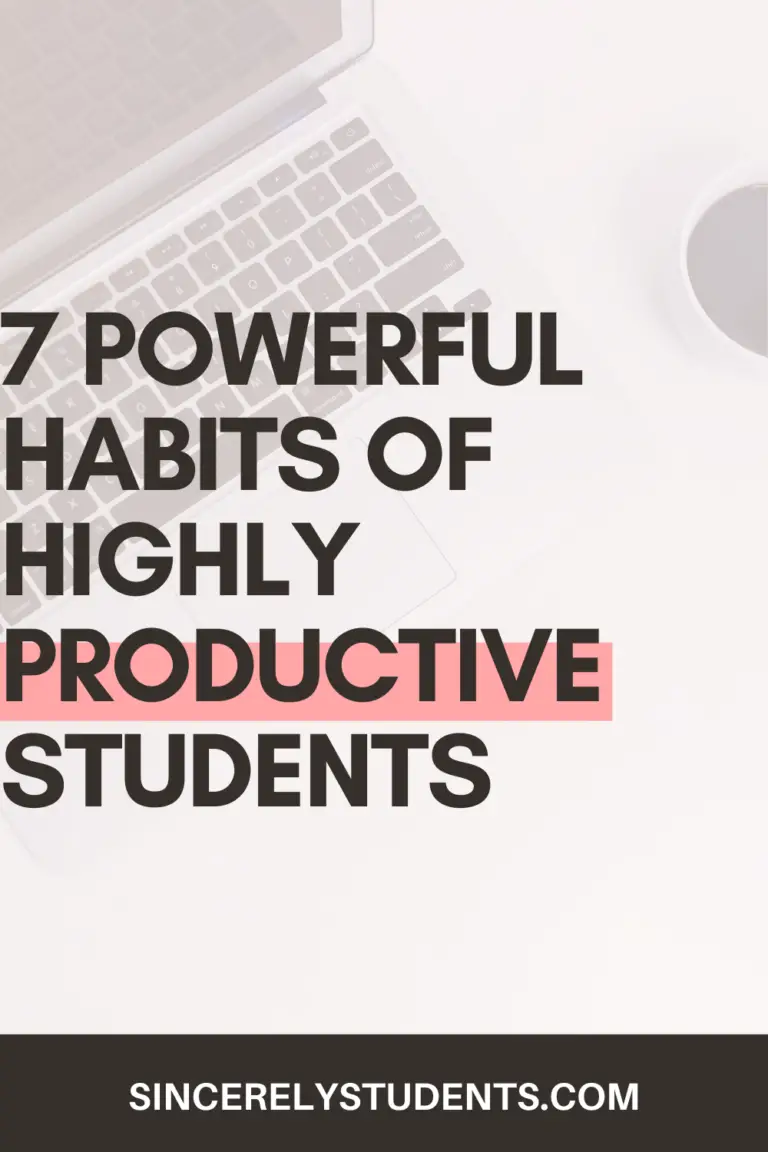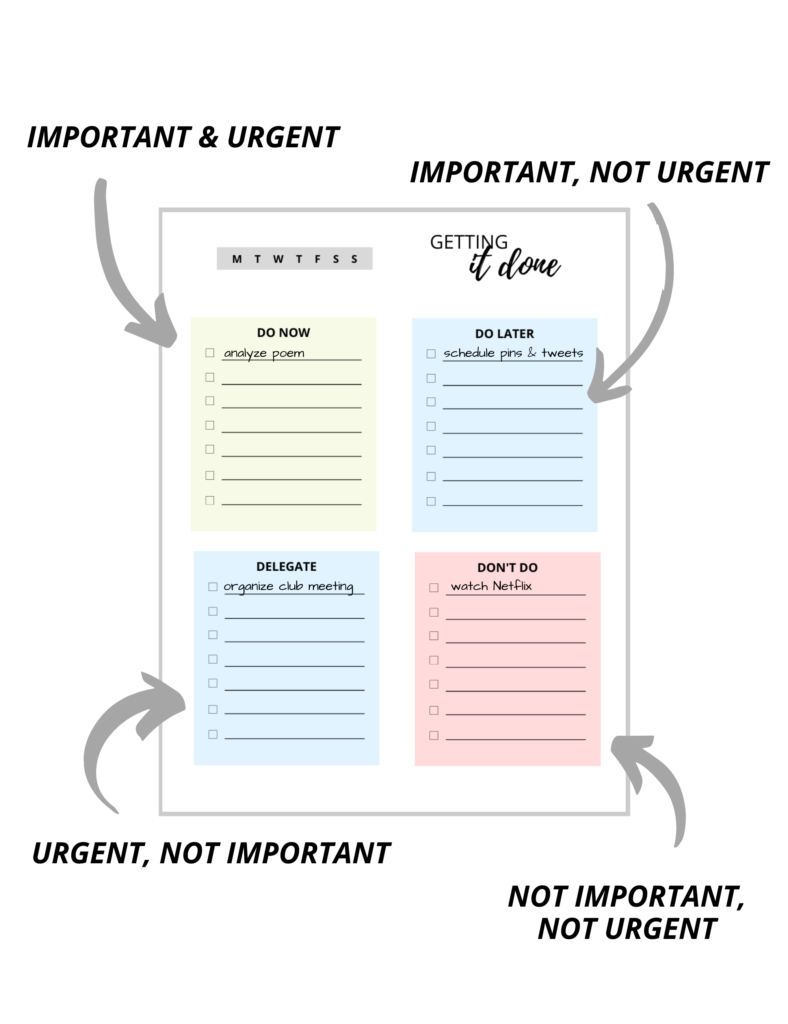Everyone wants to get more done in less time, right?
Maybe you want to finish your homework quickly so you can watch your favorite show later. But you keep getting distracted, so you end up doing only half of your homework and missing the episode.
Does that sound familiar to you? If so, you’re at the right place.
Productivity doesn’t have to be difficult nor confusing. There are small but powerful things you can do right now to start becoming a highly productive person.
Check out these 7 simple yet powerful tricks that will help you become a productivity machine!

Use The Eisenhower Matrix
The Eisenhower Matrix is also known as the “Urgent-Important Matrix”, and is named after the 34th President of the United States– Dwight D. Eisenhower.
The Matrix lets you determine the priorities of your tasks. The Matrix has 2 parameters: importance and urgency. Here’s an example of how it works (I’ve included some sample tasks to help you understand):

By using the Matrix, you can determine which tasks you need to do ASAP, which tasks you can do later, which tasks you can ask others to do, and which tasks (or bad habits) to cut completely.
It’s super helpful to everyone who has both short and long-term projects, as well as those who find themselves pushing off the big projects until it’s too late.
You can download a free printable of the Eisenhower Matrix in my Freebie Library!
Break Things Down
It’s easy to get overwhelmed by big and bulky tasks. In order to tackle things like that, you can break it down into smaller pieces.
Nobody wants to sit down for 6 hours at a time to complete a project. Especially if you don’t really enjoy doing that thing. But it becomes a lot easier when the project is divided into a dozen 30-minute tasks.
However, a SUPER important thing to remember is that you are the one actively dividing up the project. You are controlling how much time you spend or how much you get done, not the other way around.
This means you must decide (in advance) how you’re going to divide up the project and stick with it. If you planned to complete 10 practice problems each day, you are not going to answer 7 questions today then give up and do 13 tomorrow.
Plan Ahead
Planning ahead will give you structure in your daily activities. It will also keep you on task and hold you accountable.
Let’s take an example.
You have a really important research essay to write, and it has to have at least 5 body paragraphs and 2000 words. You decide to break it down and plan small tasks over 9 days. Here’s what your plan looks like:
Day 1 & 2: Research & find at least 5 sources
Day 3 & 4: Research additional sources if needed create an essay outline
Day 5 & 6: Write the essay
Day 7 & 8: Revise the essay
Day 9: Extra day for more revision
By making a plan like this, you’re setting mini-goals each day to act as stepping stones to your final goal; they help you stay motivated and productive. You can even plan each day to the hour and make it super detailed.
Of course, you want to plan your tasks according to your own abilities and workload. This is the beauty of planning ahead! You can divide tasks however you’d like to maximize your own productivity.
You can’t plan without a planner! Planners help you keep track of all the mini-goals you make, and you can reference it every time you forget what your to-do list is. And, planners can help you plan out the month, week, or even day into super-detailed schedules to help you stay on task and be ultra-productive.
This Undated Productivity Journal will help you do all that! It’s packed with pages of spreads and schedules and is the ultimate and only planner you’ll need. You can set long-term goals, weekly goals, daily priority tasks, and more. It’s the most intuitive yet effective planner I’ve used, so I definitely recommend checking it out.
Find Your Peak Hours
Some people are early birds and get all their work done before anyone else is even awake. Others are night owls who find bursts of inspiration at 1 am. Many are somewhere in between.
Determine when you are most productive and make use of that burst of energy! If you get the most done in the afternoon between 1 pm and 5 pm, plan ahead and assign yourself the most tasking work then.
Meanwhile, if you find yourself pretty much brain-dead in the mornings, take that time to relax and prepare for the day. There’s no use trying to force productivity!
Schedule Breaks
Breaks are underrated.
Taking a break is super important to help you replenish energy during the day so you can become even more productive after your break!
When you’re planning out your day, remember to leave 5-15 minutes of nothing between your tasks. Let’s go back to the essay example!
You’re on the 5th day of the research essay, and you’ve begun writing the essay body. Plan out your schedule so that you write for about 25 minutes, and then rest for 5 minutes. This is called the Pomodoro Technique, and it’s very well-known in the productivity world.
Giving yourself extra time to complete a task is also a great form of scheduling breaks. Let’s say you usually take 2 hours to complete your school homework. In your planner, give yourself an extra 15-20 minutes to complete homework!
When you leave some buffer time, your subconscious feels a sense of achievement after you complete the task “early” and feels extra motivated and productive for your next task. It’s a win-win situation!
Separate Leisure From Work
As I mentioned in my last post, How To Set Up Your Desk For Maximum Productivity, having different areas for relaxing and for working is super important. Over time, your body automatically goes into “grind mode” at your work area (usually your desk).
This means that if you sometimes do homework at your desk and other times in your bed, your body gets confused. You won’t be able to maximize productivity in either of those areas.
Similarly, if you occasionally switch between studying and playing games at your desk, your subconscious can’t tell what the desk is actually for. What are you actually wanting to do when you sit down at your desk?
Therefore, you must separate your study area from your relaxation area. This shouldn’t be too hard! You can dedicate your desk (and only your desk) to productive work, and everywhere else (like your bed or the dining table) to games and relaxing.
Make sure to check out my last post to learn how to properly set up your desk to be the most productive you can! Especially during online school, it’s crucial to have an organized area where you can focus and be highly productive.
Take Care Of Your Body
Last but certainly not least, you must take good care of your body. Without a healthy, functioning body, you dan’t do anything except trying to get better!
Here are just a couple things you should make sure to do every single day:
- Drink enough water
- Get at least 7-8 hours of sleep
- Don’t skip breakfast
- Stretch/exercise after sitting for a long time
- Rest your eyes after staring at a screen for a long time
And of course, while COVID-19 is still going around, remember to wear a mask, avoid big crowds, and wash your hands often!
Conclusion
Everyone wants more time to do things they want. But not everyone looks for ways to be productive. So if you read this post, congrats! You’re already halfway to being a highly productive person!
If you’re looking for more posts on productivity, check out these related posts: